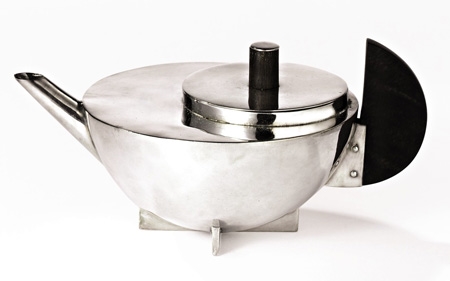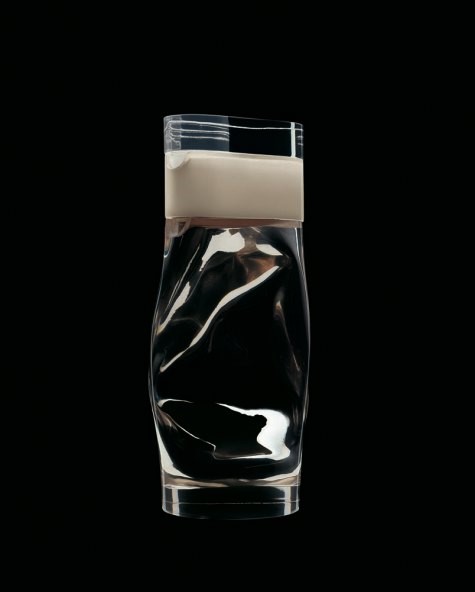The Changing Design of the Modern Teapot
Left: Marianne Brandt, Tea-essence pot (1924), London, British Museum
Right: Ben van Berkel and Caroline Bos, Tea/Coffee Tower (2001-2003), Milano, Alessi Firm
I'm a little teapot, short and stout
Here is my handle (place one hand on corresponding hip to imitate handle)
Here is my spout (position other hand in air to imitate spout).
When I get all steamed up, hear me shout
Tip me over and pour me out (lean to the right to imitate pouring tea from the spout)
The popular nursery rhyme “I’m a little teapot” takes on new meaning when considering the transformation of teapot design during the 20th and 21st century. No longer simply “short and stout,” the teapot has become an item of artistic experimentation for designers who have played with its form and medium instead of mimicking the conventional shape of the porcelain derived from Asian forms. Rooted in modernist ideologies of the 1920s, contemporary designers continue to create a material culture which suits the machine age taking into consideration mass production and consumption. One way to consider the influence of modernism on the design of the teapot is to examine the impact of the Bauhaus philosophy as exemplified in the Tea-essence pot (1924) created by Marianne Brandt in comparison to the Tea/Coffee tower designed by Ben van Berkel and Caroline Bos for the “Tea and Coffee Towers Project” (2001-2003). By comparing these two innovative teapot designs, the modernist principles of unity of the arts, the embrace of abstraction, and the belief in the progress of industry are shown incorporated into design practice.
Before analyzing Marianne Brandt’s teapot design, it is important to understand the general principles of the Bauhaus philosophy. Founded in the Weimar Republic in 1919, Bauhaus was one of the most contentious and modern art schools of its day.[1] The founder of Bauhaus, Walter Gropius, decided to fuse together the fine arts academy with the study of craft by combining both schools under one roof. Until this integration, the two disciplines had been traditionally separated in the academic art world. Accordingly, the unity of the arts was an integral part of the Bauhaus curriculum as the architect Taut stated, “There are no barriers between handicraft and sculpture or painting, they are all one building.”[2] Along with this unorthodox dialogue between the arts which encouraged the creation of objects that were both functional and aesthetically pleasing, Gropius took a step further in his teaching philosophy by emphasising the need for an inter-relationship between art and industry in the modern era. In contrast to the aesthetic beliefs of the then prevailing Art Nouveau movement, which viewed the machine as the antithesis of good design.[3] Bauhaus embraced industrial technology for its potential in aiding mass production. This new approach to the applied arts became symbolically cemented when Bauhaus adotped the slogan in 1923, “Art into Industry.” [4]
As a member of the metalwork studio of Bauhaus, Marianne Brandt assimilated these modernist principles of industrial design. Brandt was particularly influenced by the director Laszlo Moholy-Nagy, whose interest in Constructivism inspired her greatly,[5] as seen in the geometric forms of the Tea-essence pot. In contrast to the traditional ceramic teapot of the nineteenth century, often having a painted and ornamental ceramic surface, Brandt chose to let her teapot’s shape and medium ‘speak for itself.’ She combined brass, silver-plate, and ebony to create a modern version of the iconic domestic object. The lack of superfluous details on Tea-essence pot reflects the Bauhaus rejection of unnecessary decoration that does not contribute to the utilitarian purpose of the object. Instead the abstract forms that compose the object replace the visual role of ornamentation. In Brandt’s teapot, the abstract geometric arrangement of the hemisphere, circle, and cylinder constitutes the shape of the teapot and provides visual interest. Brandt’s use of abstract geometric forms is not only an artistic choice in favor of the avant-garde but is also in keeping with the Bauhaus promotion of the rationalization process that is implicit in industrialisation.[6] Brandt, like her Bauhaus colleagues, believed that simplistic forms were best suited for mass production. The harmonious composition of the geometric forms comprising Brandt’s teapot is pleasing to the eye as well as functional with the off-centred lid of this teapot preventing leakage when pouring. Tea-essence pot successfully embodies the Bauhaus principle that form follows function while simultaneous providing a new variation on a classic object.
Interestingly, although Brandt’s teapot has the appearance of a machine-produced object, it is actually handmade; Brandt personally hammeredout the metal. [7] The handcrafted construction of this teapot violates the Bauhaus principle that objects should be mass-produced for the mass consumer. Brandt further violates this principle by using expensive materials of silver plate and ebony to create it. Although both materials have functional aspects (the silver helps the tea stay warm and the ebony is heat resistant making it easier to grasp), they would not have been used on a mass-production line. While the issues of construction and medium seem to transgress Modernism’s embrace of industry, it is important to note that Brandt’s teapot albeit unique and expensive was intended as a prototype for machine manufactured replicas. This mix of craft techniques and industrial aesthetics in the creation of Brandt’s teapot demonstrate the industrial challenges faced by avant-garde designers the early 20th century who aspired to fuse good design with mass production.
With the beginning of the 21st century, teapot design was once again updated or “modernized” with the help of the Alessi project called “Tea and Coffee Towers” (2000-2003). With the aim to “renew the domestic landscape,”[8] the Alessi firm invited twenty-two architects to create tea and coffee sets in a design factory environment, an atmosphere evoking the Bauhaus environment. The fact that architects rather than experienced industrial designers were commissioned by the Alessi firm harkens back to the Bauhaus belief in the unity of the arts whereby an artist should be able to explore all visual fields. One design in the Alessi project created by designers from the Dutch firm MRDV which particularly echoes the Modernist philosophy is the Tea/Coffee Tower. Despite almost a century between the two teapots, there are many similarities between the Tea-essence pot by Marianne Brandt and the Tea/Coffee Tower designed by Ben van Berkel and Caroline Bos. For instance, the issue of practicality that is evident in the Tea-essence pot is also seen in the Tea/Coffee Tower The Dutch designers of the Tea/Coffee Tower introduced a practical element to facilitate the ritual of tea through ‘stacking.’ While Brandt combine geometric shapes in her teapot design, Berkel and Bos superimpose three objects transforming their teapot into a whole tea set. Thus, the Tea/Coffee Tower is made up of three containers of tea/coffee, milk, and sugar, all of which have the same diameter but vary in height and ratio. When these containers are stacked, a vase-like object is formed. Berkel and Bos have commented that they envisioned their design to evoke the movement of waves in the sea.[9]
Similar to how Brandt must have studied the established form of the porcelain teapot, Berkel and Bos surely considered the shape of the thermos flask; this association is reinforced by the thermoplastic resin material which is used in the Tower providing insulation like that of a thermos. Also, the use of thermoplastic resin allows for transparency which is both functional (allowing the user to view the contents) as while as aesthetic (providing visual interest in the various colorations). Instead of an ebony handle, Berkel and Bos eliminate the need for a handle at all by creating two ‘pinches’ on the tower where the user can grasp the object for carrying. Thus, the interest of teapot designers in the ergonomics of pouring evolved from Brandt’s off-centred lid to the narrowed points along the sides of Berkel and Bos’s tower. Although Tea/Coffee Tower is radically different in shape and material compared to the Tea-essence pot, both objects emphasise the union between art and technology. While Marianne Brandt’s design aesthetically reflects the links between Modernism and industry, Berkel and Bos utilize technological advancements including new plastic materials and computer design to create a modern object that is sculptural and functional.
Even with this one comparison between the Tea-essence pot and the Tea/Coffee Tower, it is clear that the ideals developed by the Modernists continue to influence the way everyday objects are designed. With the emergence of the industrial designer profession exemplified by the Marianne Brandt and Alessi “virtualist architects,”[10] it is clear that the Modernist dream for the unity of the arts is being realized. A designers’ adoption of the avant-garde principles of abstraction is no longer a pioneering endeavour but rather a well-established means of creative exploration. Since the teapot is an enduring object in our material culture, designers can apply their new aesthetics to this “chameleonic still-life.”[11] With the machine age giving way to the virtual world, it will be fascinating to observe how future teapots will be reinterpreted - perhaps soon, each child will pose differently when they sing “I’m a little teapot.”
Enjoyed reading? Subscribe to our newsletter.
Ahlstrom Appraisals | Personal Property Appraisals and Art Consultations | Serving Atlanta & Southeast | Fine Art, Antiques & Vintage
[1] Magdalena Droste, Bauhaus 1919-1933 (London: Taschen, 2002), 17.
[2] Ibid., 17.
[3] Alastair Duncan, Art Deco (London: Thames & Hudson Ltd, 2001), 118.
[4] Alexandra Griffith, “The Bauhaus, 1919-1933,” In Heilbrunn Timeline of Art History (New York: The Metropolitan Museum of Art, 2000), 1.
[5] Michael Collins, Towards Post-Modern Design: Design since 1851 (London: British Museum Press, 1994), 69.
[6] Kathleen James-Chakraborty ed., Bauhaus Culture, From Weimar to the Cold War (London: University of Minnesota Press, 2006), XI.
[7] Michael Collins, Towards Post-Modern Design: Design since 1851 (London: British Museum Press, 1994), 68.
[8]Alessandro Mendini ed., Tea & Coffee Towers (Milano: Electa, 2003), 7.
[9] Ibid., 17.
[10] Ibid., 17.
[11] Ibid., 9.

